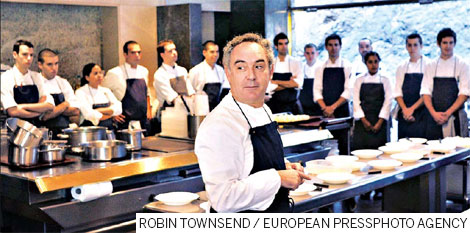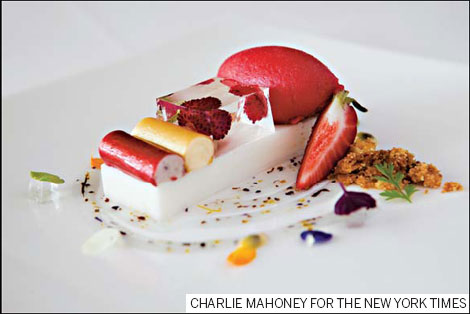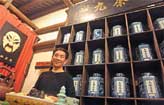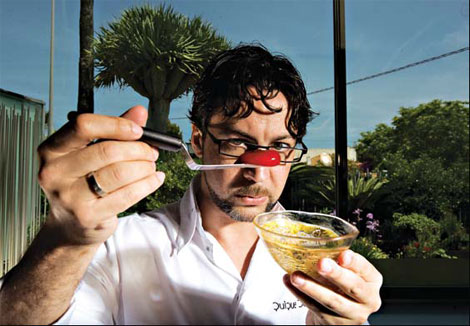Delicacies
Food artists, looking to fill a gap
Updated: 2011-07-31 08:23
By Julia Moskin (The New York Times)


|
Young chefs like Quique Dacosta, whose restaurant is in Valencia, are exploring new media for cuisine. Carme Ruscalleda's architectural strawberry dessert, middle, made with quark and yuzu. Top, Ferran Adria. Denis Doyle for The New York Times |
El Bulli closes, and new innovators emerge
El Bulli, which has been the most influential restaurant in the world, served its last dinner on July 30. The next morning, Spain's chefs woke up to a radically changed universe.
In a single generation, El Bulli helped transform Spain from a culinary backwater to a world leader, and Ferran Adria's cocina de vanguardia (the term he and other chefs prefer to "molecular gastronomy") became a global obsession among young chefs.
As Antoni Gaudi transformed the country's architecture and Pedro Almodavar its cinema, Mr. Adria redefined its cuisine into performance art. Although many chefs contributed to Spain's gastronomic revolution, especially Juan Mari Arzak, Santi Santamaria and Andoni Luis Aduriz, it was the sustained daring of Mr. Adria himself that kept the bar rising.
"It is impossible to say too much about his influence," said Carme Ruscalleda, a chef in Catalonia who has six Michelin stars to her name, more than any other woman in the world. "He was the first one to tell the chefs of Spain we could think for ourselves."
Tourists from all over the world now come to Spain for the food, drawn by the mystique of El Bulli, even though only a few hundred managed to eat there each year. Many chefs fear that the closing of El Bulli will combine with European economic woes to create a general plunge in culinary tourism.
"I don't think it's a good situation," said Josep Roca, one of the brothers who own Can Roca, a destination restaurant north of Barcelona. "I am afraid that without El Bulli, a certain energy will disappear from the restaurant scene here."
But El Bulli is not completely finished: Mr. Adria and his team intend to reopen it, reinvented, in two years. In the meantime, it is dawning on chefs that the Adria monopoly on the world press may finally be broken.
"The cuisine of El Bulli and Ferran Adria has been so huge that it eclipses whatever is beside it," said Quique Dacosta, an avant-garde chef in Valencia.
"Now other chefs will have more opportunities, occupying the spaces that El Bulli and Ferran Adria will leave," said Rafael Ansón, the president of the Royal Spanish Academy of Gastronomy.
Who will be the new darling of the gastro-tourists? Many chefs, including Mr. Dacosta (known for his edible landscapes), Josean Martinez Alija (famous for groundbreaking work with vegetables) and Ms. Ruscalleda are contenders.
One group plans to keep pushing the boundaries of cuisine with new technologies and global ingredients. Another group is vigorously digging into the roots of Spanish cuisine.
Young chefs like Mr. Dacosta, in Valencia, are exploring new media for cuisine. He is the creator of Oyster Guggenheim Bilbao, a single oyster, heated over juniper wood and draped in a film of edible titanium-silver alloy that mirrors the surfaces of Frank Gehry's museum.
Paco Morales, the chef at the Hotel Ferrero in Valencia, takes a jellied tomato water and scatters it with local herbs and shavings of raw vegetables, evoking a Market in a Dish.
Nandu Jubany, Victor Arguinzoniz and Mari Carmen Velez are leaders in a regresar a las raices (return to roots), using local ingredients and traditional techniques, but refined to an extraordinary level.
A loud voice of the back-to-the-land movement was silenced in February by the death of Santi Santamaria, the popular Catalan chef of the three-Michelin-starred Can Fabes in Sant Celoni. Mr. Santamaria was virtually the only Spanish chef to openly challenge Mr. Adria's work - calling it unhealthy and, far worse in Spain, dishonorable.
Xavier Pellicer, who was trained by Mr. Santamaria, has taken over the kitchen at Can Fabes. He is already stirring the pot with creations like a crab creme brulee with a lid of caramelized sugar and black pepper.
One chef (perhaps the only one) who transcends the rivalries and cliques among Spanish chefs is Ms. Ruscalleda, a self-taught, self-employed 58-year-old.
Although she is little known outside Spain, within it she is respected as a true artist and fierce perfectionist. Her food is delicate and minimal. It is also full of flavor.
Whether Spain will descend from the dizzying heights that it reached during the El Bulli era remains to be seen, but the language of cuisine, both on the plate and on the page, has been transformed by it.
When asked whether the faltering Spanish economy will continue to sustain expensive and experimental cuisine in the future, Mr. Dacosta's answer was characteristic:
"What is expensive? What is experimental? What is the future?"
The New York Times

Specials

Carrier set for maiden voyage
China is refitting an obsolete aircraft carrier bought from Ukraine for research and training purposes.
 Photo
Photo  Video
Video

Pulling heart strings
The 5,000-year-old guqin holds a special place for both european and Chinese music lovers

Fit to a tea
Sixth-generation member of tea family brews up new ideas to modernize a time-honored business
